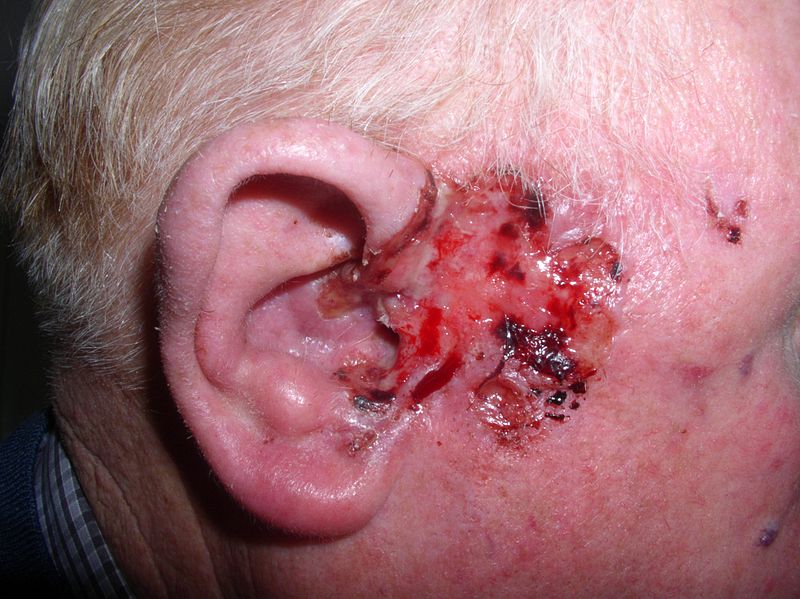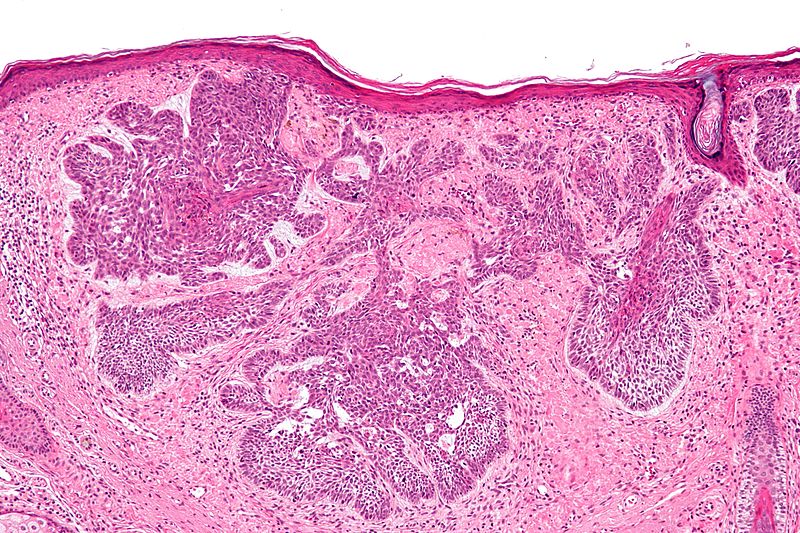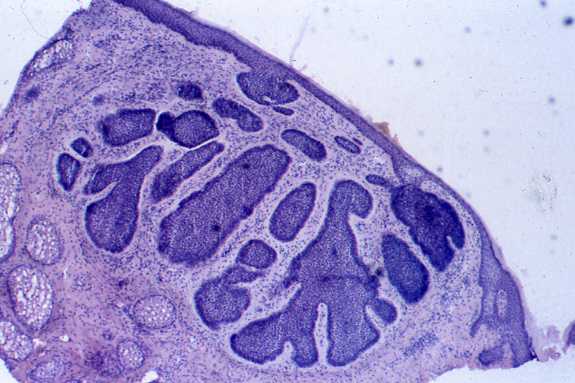Basal cell carcinoma pathophysiology: Difference between revisions
No edit summary |
No edit summary |
||
| Line 8: | Line 8: | ||
==Pathophysiology== | ==Pathophysiology== | ||
===Genetics=== | ===Genetics=== | ||
*Basal cell carcinoma may develop as a result of basal cell nevus syndrome (Gorlin's syndrome) which is additionally characterized by odontogenic keratocysts of the jaw, palmar or plantar (sole of the foot) pits, calcification of the [[falx cerebri]] (in the center line of the brain), and rib abnormalities | *Basal cell carcinoma may develop as a result of basal cell nevus syndrome (Gorlin's syndrome) which is additionally characterized by odontogenic keratocysts of the jaw, palmar or plantar (sole of the foot) pits, calcification of the [[falx cerebri]] (in the center line of the brain), and rib abnormalities | ||
*The cause of the syndrome is a mutation in the [[PTCH1]] tumor-suppressor gene at chromosome 9q22.3, which inhibits the [[hedgehog signaling pathway]] | *The cause of the syndrome is a mutation in the [[PTCH1]] tumor-suppressor gene at chromosome 9q22.3, which inhibits the [[hedgehog signaling pathway]] | ||
*A mutation in the [[smoothened|SMO]] gene (also on the hedgehog pathway) predisposes to the development of basal cell carcinoma<ref>{{cite journal |author=Epstein EH, Shepard JA, Flotte TJ |title=Case records of the Massachusetts General Hospital. Case 3-2008. An 80-year-old woman with cutaneous basal-cell carcinomas and cysts of the jaws |journal=N Engl J Med |volume=358 |issue=4 |pages=393–401 |year=2008 |month=Jan |pmid=18216361 |doi=10.1056/NEJMcpc0707893 |url=}}</ref> | |||
===Enviromental Exposure=== | ===Enviromental Exposure=== | ||
Revision as of 14:36, 5 August 2015
|
Basal cell carcinoma Microchapters |
|
Diagnosis |
|---|
|
Case Studies |
|
Basal cell carcinoma pathophysiology On the Web |
|
American Roentgen Ray Society Images of Basal cell carcinoma pathophysiology |
|
Risk calculators and risk factors for Basal cell carcinoma pathophysiology |
Editor-In-Chief: C. Michael Gibson, M.S., M.D. [1];Associate Editor(s)-in-Chief: Shivali Marketkar, M.B.B.S. [2]
Overview
Basal cell carcinomas develop in the basal cell layer of the skin. Cumulative DNA damage caused by chronic sunlight exposure results in DNA mutations that predispose to the development of basal cell carcinoma. On gross pathology, basal cell carcinoma lesions may demonstrate pearly pink nodules with telangiectasias, rolled borders, and central crusting with or without an ulcerating lesion (rodent ulcer). On microscopic analysis, peripheral palisading nuclei are characteristic.
Pathophysiology
Genetics
- Basal cell carcinoma may develop as a result of basal cell nevus syndrome (Gorlin's syndrome) which is additionally characterized by odontogenic keratocysts of the jaw, palmar or plantar (sole of the foot) pits, calcification of the falx cerebri (in the center line of the brain), and rib abnormalities
- The cause of the syndrome is a mutation in the PTCH1 tumor-suppressor gene at chromosome 9q22.3, which inhibits the hedgehog signaling pathway
- A mutation in the SMO gene (also on the hedgehog pathway) predisposes to the development of basal cell carcinoma[1]
Enviromental Exposure
- Basal cell carcinomas develop in the basal cell layer of the skin
- Cumulative DNA damage caused by chronic sunlight exposure results in DNA mutations that predispose to the development of basal cell carcinoma
- While DNA repair eliminates most UV-induced damage, not all cross-links are excised, which eventually results in mutations
- Apart from the mutagenesis, sunlight depresses the local immune system, possibly decreasing immune surveillance for new tumor cells
Gross Pathology

The image above depicts basal cell carcinoma in a 75 year old male. The following features are characteristic on gross pathology:
- Pearly pink nodules
- Telangiectasias
- Rolled borders
- Central crusting
- Ulcerating lesion (rodent ulcer)
Microscopic Pathology
Shown below is a classic micrograph of basal cell carcinoma(H&E stain).The following features are characteristic:
- Peripheral palisading nuclei
- Myxoid stroma
- Artefactual clefting

Shown below is the image of nodular variant of Basal cell carcinoma

Video
{{#ev:youtube|JnJXrFnvOKs}}
References
- ↑ Epstein EH, Shepard JA, Flotte TJ (2008). "Case records of the Massachusetts General Hospital. Case 3-2008. An 80-year-old woman with cutaneous basal-cell carcinomas and cysts of the jaws". N Engl J Med. 358 (4): 393–401. doi:10.1056/NEJMcpc0707893. PMID 18216361. Unknown parameter
|month=ignored (help)